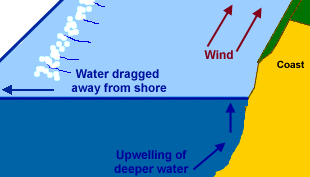
Coastal upwelling is a process that supports a high productivity of the ocean waters. Oceanic productivity is high where the availability of sunlight combines with high levels of nutrients.
In coastal upwelling the prevailing wind, assisted by the rotation of the Earth, drives the surface layer away from the coast. This forces water from deeper layers to rise to the surface near the coast.

In the open ocean dead plant and animal matter falls slowly through the ocean depth and is remineralized (composted) into nutrients. As a result, nutrients accumulate in the deeper layers but cannot be used for biological production because of the absence of light.
Coastal upwelling regions are highly productive because the upwelling brings the nutrients stored at depth back into the surface layer. The Peruvian upwelling region supported and still supports one of the largest fisheries of the world.